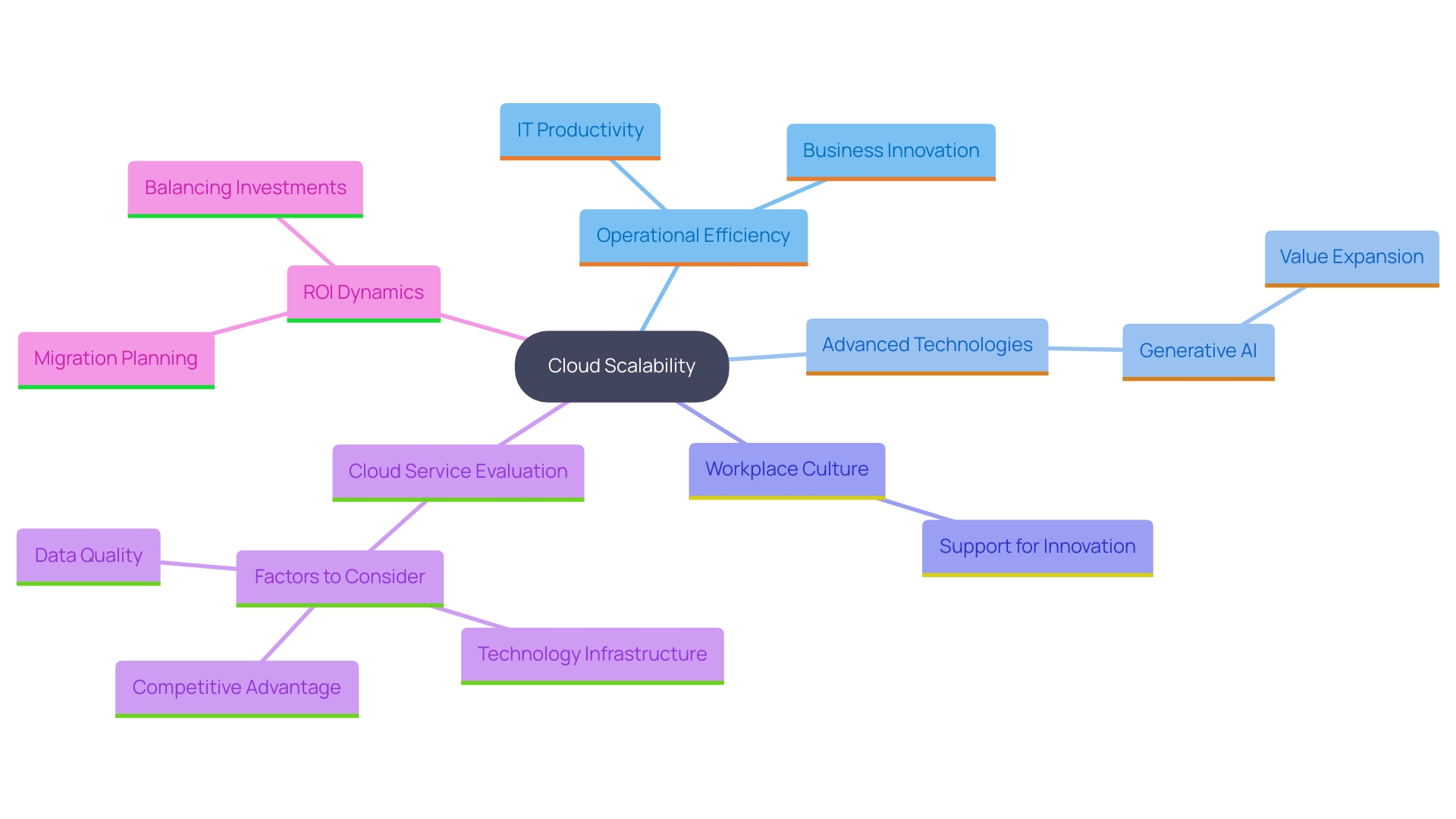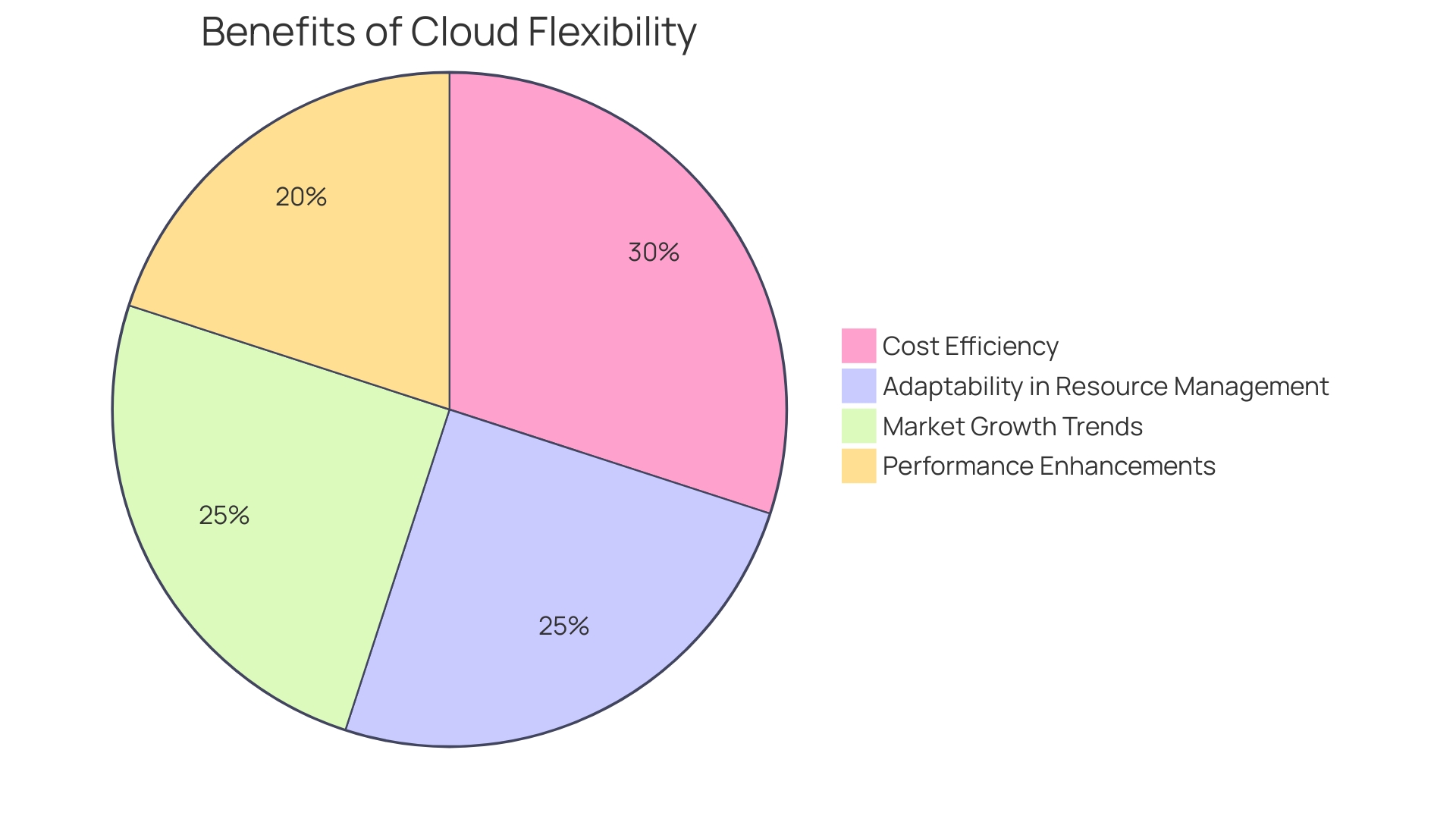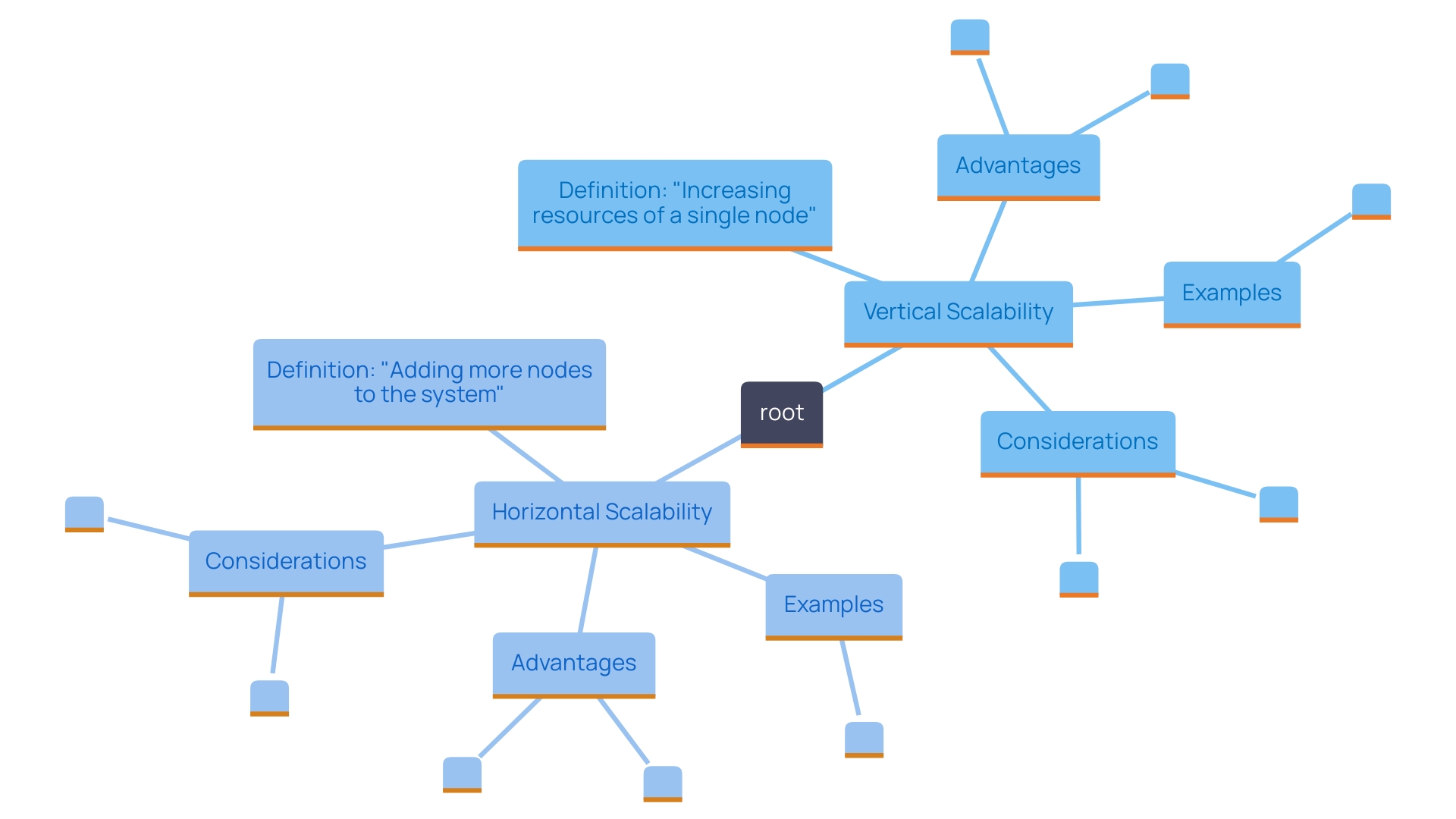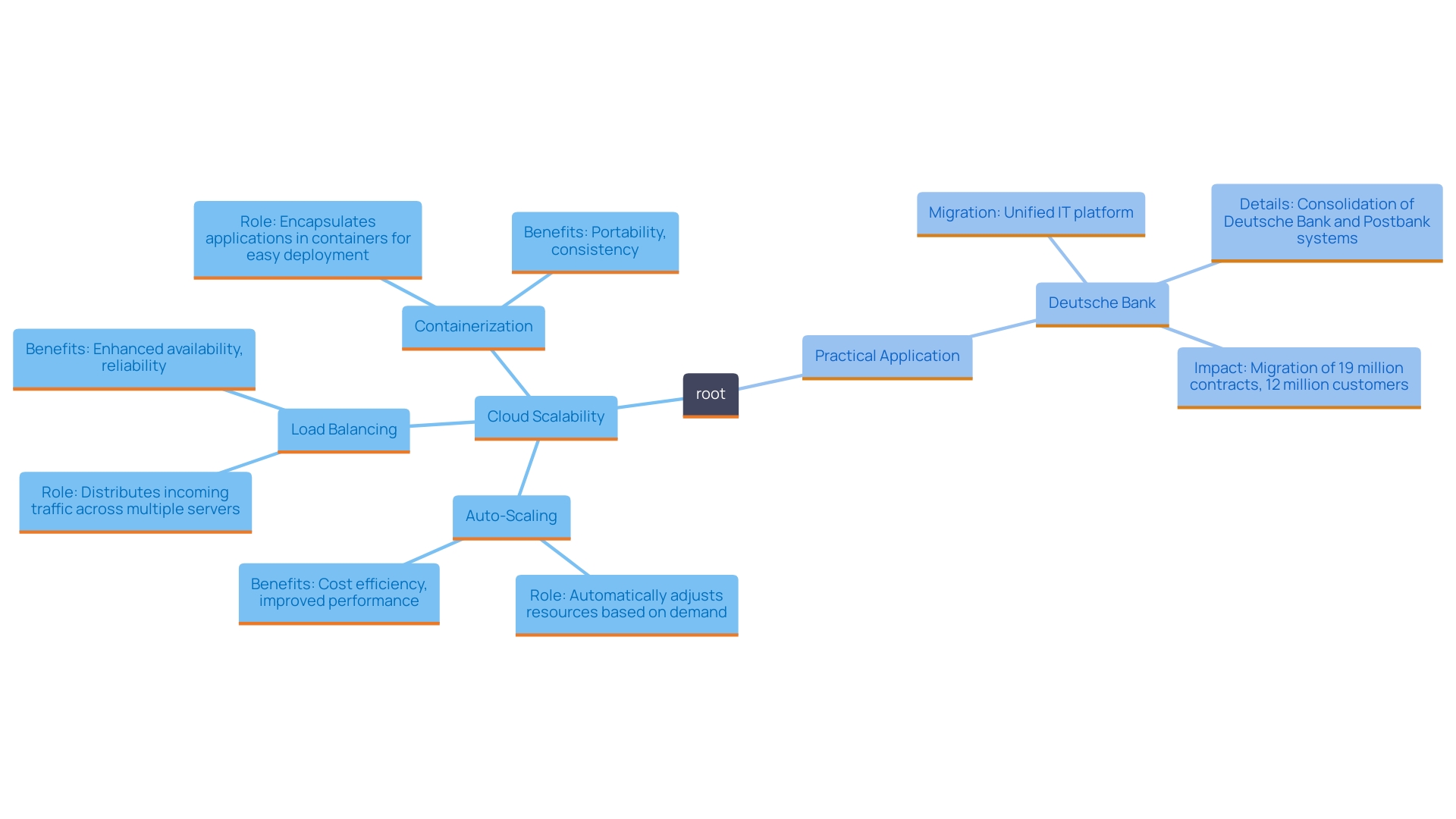Introduction
In the rapidly evolving landscape of technology, cloud scalability emerges as a pivotal factor for organizations seeking to optimize their operations and respond adeptly to fluctuating demands. This capability enables businesses to dynamically adjust their resources, ensuring applications maintain peak performance even amidst significant usage spikes. As enterprises navigate the complexities of modern infrastructure, the advantages of cloud scalability extend beyond mere technical enhancements, influencing overall business strategy and innovation.
From cost efficiency to improved performance, the benefits are manifold and crucial for sustaining competitive advantage. Furthermore, understanding the different types of scalability—vertical and horizontal—becomes essential for organizations looking to tailor their approach to specific needs. Exploring effective strategies such as auto-scaling, load balancing, and containerization can provide deeper insights into achieving an agile and resilient cloud environment, ultimately fostering sustained growth and operational excellence.
What is Cloud Scalability?
'The ability of the cloud to expand is a crucial aspect of cloud computing that enables resources to dynamically adjust according to fluctuating demands.'. This adaptability ensures that applications can manage varying loads effectively, thereby maintaining optimal performance and delivering a seamless user experience. For instance, a website experiencing a sudden surge in traffic—from 1,000 visitors one day to 100,000 the next—relies on its scalability features to automatically adjust resources, such as bandwidth and server capacity, in real time.
This capability is not merely a technical advantage; it represents a fundamental shift in how entities approach infrastructure. As detailed in industry reports, many companies are recognizing the true value of online computing, particularly in terms of IT productivity and business innovation. By utilizing advanced technologies, including generative AI, companies can improve their digital investments and maximize returns. This dynamic environment fosters not only operational efficiency but also the potential for creative solutions, as exemplified by Procentrix, which emphasizes the importance of its workforce in driving innovation through a supportive workplace culture.
The need for adaptable online solutions is clear, as companies are placing greater emphasis on flexibility to address their changing requirements. A robust cloud infrastructure allows businesses to explore different pathways for cloud programs, each impacting their return on investment (ROI) trajectory. As entities evaluate their IT environments, they are also encouraged to find suppliers with demonstrated success in growth, robust security protocols, and a wide array of services that correspond with their strategic goals.

Benefits of Cloud Scalability
'Cloud flexibility provides businesses a variety of benefits that greatly improve their operational effectiveness and responsiveness.'. One of the most compelling benefits is cost efficiency; businesses only incur expenses for the resources they actually utilize. This pay-as-you-go model allows companies to optimize their budgets, especially in fluctuating market conditions.
Furthermore, the expansion of virtual environments offers unmatched adaptability in resource administration. Companies can swiftly adjust their resource allocation in response to changing demands. For example, during peak-traffic occasions, entities can enhance their infrastructure effortlessly, guaranteeing that software remains responsive and dependable. This capability is crucial for maintaining user satisfaction, particularly in competitive industries.
Enhancements in performance are an additional important benefit of flexible resource management. By utilizing online solutions, organizations can ensure that their applications function smoothly, even during peak usage times. This improved performance is vital for maintaining customer trust and engagement. James Kelty, Head of Infrastructure at Chess.com, emphasizes this point, stating, "By providing a digital version of chess, the company has been able to reach a more global audience, bringing together players from different regions of the world." Such flexibility supports platforms that experience significant user engagement, ensuring they can handle millions of interactions without compromising quality.
The importance of flexible resource management is further emphasized by market trends. The computing market is anticipated to expand from a revenue of $723.4 billion in 2023 at a compound annual growth rate (CAGR) exceeding 18%. This growth is mainly fueled by the growing integration of IoT devices and the escalating demand for artificial intelligence (AI), showing a clear connection between flexible infrastructure and emerging technologies that improve business operations.

Types of Cloud Scalability
The ability to expand resources is a fundamental aspect of contemporary online computing, enabling organizations to adjust rapidly to evolving requirements. It is mainly classified into two unique categories: vertical expansion and horizontal expansion.
-
Vertical Scalability (also known as scaling up) involves enhancing the resources within a single instance. This can be achieved by adding more CPU power or RAM to an existing server. For instance, a financial service platform may choose vertical scaling to handle increased transaction loads during peak hours, thus ensuring uninterrupted service.
-
Horizontal Scalability (scaling out), on the other hand, focuses on increasing capacity by adding more instances or servers. This method is often favored in distributed systems where load balancing is essential. For example, Nubank, a Brazilian FinTech company, successfully scaled horizontally by deploying hundreds of microservices across its cloud infrastructure. This allowed them to flexibly manage their substantial user base of 80 million customers without compromising performance.
The selection between vertical and horizontal expansion mainly relies on particular business requirements. Vertical scaling can be simpler to implement but may hit resource limits, while horizontal scaling can provide greater flexibility and resilience to failures, albeit at a potentially higher complexity in management.
As companies keep growing, comprehending and implementing the appropriate expansion strategy becomes essential for ongoing development. Through meticulous preparation and implementation, entities can guarantee their systems are not merely satisfying present requirements but are also safeguarded for development, thereby handling growth wisely and sustainably.

Achieving Cloud Scalability
Achieving effective cloud scalability requires organizations to implement a multifaceted approach, incorporating auto-scaling features, load balancing, and containerization strategies. Auto-scaling enables resources to be dynamically modified in reaction to fluctuating workloads, ensuring that systems sustain optimal performance during peak and off-peak times. As noted in recent discussions, scaling a web platform is not a one-time effort but a continuous process that demands careful planning to balance architecture, database solutions, and operational tools.
Load balancing plays a crucial role in distributing incoming traffic across multiple servers, enhancing responsiveness and availability of services. This method not only improves user experience but also ensures that no single server becomes a bottleneck. A thorough load balancing approach can greatly improve the robustness of online services, especially in high-demand situations.
Containerization further supports scalability by allowing software to be packaged with all its dependencies. This ensures consistent execution across different environments, facilitating easier updates and scaling. The use of container orchestration tools can automate the deployment, scaling, and management of containerized software, thereby streamlining the resource management process in a virtual environment.
For instance, Deutsche Bank's recent migration to a unified IT platform exemplifies the successful application of these strategies. By collaborating with Google Cloud, they successfully shifted from conventional on-premises servers to a contemporary digital infrastructure, overseeing the transfer of millions of customer accounts and product contracts. This transition was not only a technical achievement but also a strategic move to enhance operational efficiency and customer service.
In summary, by leveraging these technologies—auto-scaling, load balancing, and containerization—organizations can create a robust and flexible cloud environment that adapts seamlessly to changing demands, ensuring sustainable growth and optimal performance.

Conclusion
Cloud scalability emerges as an essential element in the contemporary technological landscape, facilitating organizations in their quest for operational efficiency and adaptability. By enabling resources to dynamically adjust to varying demands, cloud scalability not only enhances application performance but also transforms the strategic approach to infrastructure management. The recognition of its value is evident as businesses increasingly prioritize scalable solutions that align with their evolving needs.
The manifold benefits of cloud scalability, including cost efficiency, flexibility, and performance improvements, underscore its significance in today’s competitive environment. Organizations can optimize resource allocation and maintain a high level of user satisfaction, particularly during peak usage periods. As market trends indicate robust growth in cloud computing, the integration of advanced technologies further emphasizes the necessity for scalable solutions that foster innovation and operational excellence.
Understanding the different types of cloud scalability—vertical and horizontal—equips organizations to tailor their strategies effectively. Each approach presents unique advantages and challenges, highlighting the importance of assessing specific business requirements to determine the most suitable method for expansion.
To achieve cloud scalability, organizations must adopt a comprehensive strategy that incorporates auto-scaling, load balancing, and containerization. By leveraging these technologies, businesses can create a resilient cloud environment that not only meets current demands but is also prepared for future growth. In this rapidly changing landscape, the ability to scale efficiently is not just a technical advantage; it is a critical component of sustained competitive advantage and long-term success.




